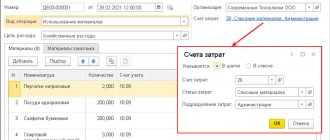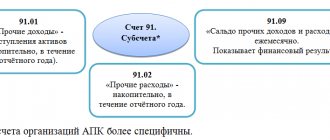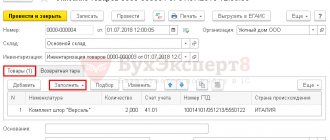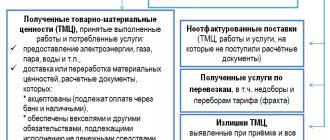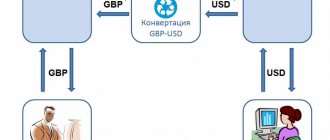Account
76 is used to distribute finances between creditors and debtors. More than 7 business transactions are provided for it. Account closed “in real time”, and not at the end of the billing period. The balance on the register can be credit or debit. To reflect mutual settlements with debtors and creditors in accounting, a register of the same name is used. It involves opening different sub-accounts depending on the transaction being performed. Let's consider the procedure and frequency of closing account 76.
Advance payments and VAT: account 76.AB
In business practice, an advance payment or advance payment is considered to be payment received by the seller on account of the future delivery of goods, upcoming services or work, or the transfer of property rights. In 1C programs, account 76.AB is used to reflect VAT on advances received. The debit of account 76.AB reflects the accrual of VAT on advances received, and the credit of account 76.AV indicates the deduction of VAT on the advance received. Account 76.AB of accounting involves maintaining analytical accounting in the context of buyers from whom the advance was received.
In addition, analytical accounting for account 76.AB is also carried out for invoices issued to customers for the advance received.
The accounting entries will be as follows:
- DT 51 CT 622 - we reflect the receipt of an advance against future supplies;
- DT 76.AV KT 68VAT - reflect the accrual of VAT on the advance payment;
- DT 621 CT 90-1 - reflect revenue from the sale of goods;
- DT 90-2 KT 41 - reflect the write-off of the cost of goods sold;
- DT 90-3 CT 68VAT - we reflect the amount of VAT accrued on sales.
After all products have been sold, the prepayment will be credited towards the full delivery:
- DT 622 subaccount “Calculations for advances received” KT621 - reflect the offset of the previously received advance;
- DT 68 VAT CT 76.AV - we accept VAT deduction from the advance received.
The only difficulty may arise due to the fact that the concept of “payment” is not defined in the Tax Code of the Russian Federation. Therefore, there may be doubts whether the receipt of goods, works or services as an advance payment rather than cash is considered prepayment.
However, in paragraph 2 of paragraph 17 of the Rules for maintaining a sales book (approved by Government Decree No. 1137 dated December 26, 2011), it is noted that invoices for prepayment should be registered in this book even for non-cash payments.
Confirmation of this thesis can be found in the resolution of the Plenum of the Supreme Arbitration Court of the Russian Federation dated May 30, 2014 No. 33. It is noted here that payment is considered made even in cases where it is expressed in non-monetary form. Offsets of counterclaims are also included in this category of payments.
That is, the receipt of an advance expressed in non-monetary form is associated with the need to calculate VAT and pay it to the budget.
Procedure for accounting for VAT on advances issued
A client making an advance payment under an agreement can deduct the amount of value added tax presented by the supplier of products or services (in accordance with article one hundred and seventy-one, subparagraph twelve of the Tax Code of the Russian Federation). The buyer has the right to refund VAT on the transferred advance payments before the date of receipt of the goods. To do this, he will need the documents listed in the one hundred and seventy-second article in the ninth subparagraph:
- invoice from the supplier who received the advance payment;
- a document confirming the actual transfer of advance funds;
- an agreement establishing an obligation to remit an advance payment.
The customer must enter the invoice into their purchase ledger. After the delivery of the goods, the client receives an invoice for the fully received shipment, the invoice must be entered into the purchase book. The invoice for the advance payment is then noted in the sales ledger.
The client can refund the entire amount of value added tax, but the tax taken as a deduction from the advance amount sent must be restored immediately, in the same quarter.
Kazakova Ekaterina Igorevna, head of the development and personnel management department at the regional retail chain of pharmacies and cosmetics stores “Ruble Boom” and 1b.ru, business coach. Expert of the site “Accounting for Dummies”.
Rate the quality of the article. We want to become better for you: If you have not found the answer to your question, then you can get an answer to your question by calling the numbers ⇓ Free legal advice Moscow, Moscow region call
One-click call St. Petersburg, Leningrad region call: +7 (812) 317-60-16
Call in one click From other regions of the Russian Federation, call
One-click call
VAT on advance payments when making payments through a third party
It may be necessary, at the seller's request, to transfer the advance payment to a third party. This operation is provided for in Art. 313 of the Civil Code of the Russian Federation, but the amount of the prepayment made must also be subject to VAT.
Example
entered into a contract for the supply of products. The agreement provides for an advance payment of 25% of the delivery amount. However, Sigma has a debt to the third, and the debtor asked Omega to transfer the entire amount of the advance to the creditor. In essence, this is a transfer of debt, which must be documented. As a result, all debts are repaid, but for Sigma the payment amount will be considered an advance payment and will definitely be subject to VAT.
If such an advance is made in the form of a debt transfer, then the postings from Sigma LLC will be as follows:
Dt 601 Kt 622 - we reflect the receipt of an advance in the form of a transfer of debt, which repays the debt to a third party;
Dt 76.AV Kt 68 VAT - we reflect the accrual of VAT on the advance payment.
Accounting entries for VAT recovery from advance payment
The VAT recovery posting will always be the same for each individual invoice:
Dt 76/VA Kt 68/2,
68/2 - subaccount for accounting for settlements with the budget for VAT on account 68;
76/VA - subaccount for accounting for VAT on advances issued in account 76.
The results of VAT recovery for specific advance invoices will vary depending on the ratio of the amount of the advance and the cost of supply associated with it:
- for the first 2 cases (the amounts of the advance and delivery are the same or the amount of the advance is less than the cost of delivery), with this posting the amount of tax on the advance, listed in subaccount 76/AB, will be closed completely;
- in the 3rd and 4th cases (the amount of the advance is greater than the cost of delivery or the contract contains a condition on partial offset of the advance towards payment for the supply), in subaccount 76/AB after the restoration of VAT there will be a balance of unrecovered tax.
Read about the latest changes in the document reflecting tax restoration operations in the material “Sales Book - 2022: new form”
.
Should advance VAT be calculated if the advance payment and shipment were in the same period?
In business practice, situations often arise in which an advance payment is received by the supplier in the same tax period when the shipment is made. The taxpayer has a doubt: in the given circumstances, is it worth calculating VAT on advance payments - after all, almost immediately you will have to make a calculation on the rest of the payment amount?
There are two opposing positions on this issue.
- The position of officials is that VAT must first be calculated on the advance payment, and then on the proceeds from sales. Both amounts of tax, in their opinion, should be reflected in the declaration for the past tax period. In the same report, VAT on the advance payment should be indicated as part of tax deductions. Confirmation of this point of view can be found in letters of the Ministry of Finance of Russia dated October 12, 2011 No. 03-07-14/99, Federal Tax Service of Russia dated July 20, 2011 No. ED-4-3/11684, 03.10.2011 No. KE-4-3/3790 and 02/15/2011 No. KE-3-3/ [email protected] , Federal Tax Service of Russia for Moscow dated 02.06.2005 No. 19-11/39279 and 31.01.2005 No. 19-11/5754. In some cases, even arbitration courts take the side of the regulatory authorities (Resolution of the Federal Antimonopoly Service of the North Caucasus District dated June 28, 2012 No. A32-13441/2010).
- However, the overwhelming majority of courts take the opposite point of view and in their decisions indicate that the payment cannot be considered an advance payment, since it came in the same tax period in which the goods were shipped. Confirmation of this position can be found in the ruling of the Supreme Arbitration Court of the Russian Federation dated September 19, 2008 No. 11691/08, resolutions of the Federal Antimonopoly Service of the North Caucasus District dated May 25, 2012 No. A32-16839/2011, FAS Volga District dated September 7, 2011 No. A57-14658/2010 (retained in force by the determination of the Supreme Arbitration Court of the Russian Federation dated January 16, 2012 No. VAS-17397/11) and the Federal Antimonopoly Service of the Far Eastern District dated December 22, 2011 No. F03-6321/2011). If you follow this logic, then there is no need to calculate VAT on advance amounts.
At the same time, the accountant has the opportunity not to issue an invoice for the advance payment if the time interval between the advance payment and shipment does not exceed 5 calendar days. Confirmation of this thesis is contained in letters of the Ministry of Finance of Russia dated 10/12/2011 No. 03-07-14/99 and 03/06/2009 No. 03-07-15/39 (clause 1). That is, the taxpayer has the opportunity not to calculate VAT on the advance payment if the five-day condition is met.
But here, too, the Federal Tax Service of Russia in letters dated March 10, 2011 No. KE-4-3/3790 and February 15, 2011 No. KE-3-3/ [email protected] explains that advance invoices should be issued even in those circumstances when which are shipped within 5 days after receiving the advance payment.
As a result, practice shows that it would be more rational to calculate tax on advance payments, even if the shipment was made in the same tax period. In this case, the tax base will not increase, and the taxpayer will be able to avoid unnecessary disputes with regulatory authorities.
Only those amounts that arrived on the day of shipment, but even before its implementation (letter of the Ministry of Finance of Russia dated March 30, 2009 No. 03-07-09/14) may not be considered an advance payment. And this is only on the basis that it is not possible to establish the order of operations based on primary documents.
Conditions for deducting tax on advances issued
When calculating the tax on the advance payment received, the seller issues an invoice for it and sends 1 copy of it to the buyer. Based on this document, the buyer has the right to take into account the amount of tax allocated in it as deductions (clause 12 of article 171 of the Tax Code of the Russian Federation). Although he may not do this, since deductions are not an obligation, but are made voluntarily (clause 1 of Article 171 of the Tax Code of the Russian Federation). It is better to consolidate the taxpayer’s position regarding deductions for advances issued (whether they will be applied or not) in some document (for example, in the VAT accounting policy).
However, these 2 circumstances (payment and invoice) are not enough for the buyer to deduct it. Additional conditions for carrying out such an operation follow from other provisions of the Tax Code of the Russian Federation:
- a condition on the possibility of transferring an advance payment must be included in the supply agreement (clause 9 of Article 172 of the Tax Code of the Russian Federation);
- The invoice for the advance payment must be dated within the 5-day period allotted for issuing such documents (clause 3 of Article 168 of the Tax Code of the Russian Federation), and have all the required details for it (clause 5.1 of Article 169 of the Tax Code of the Russian Federation).
Acceptance of deductions from the buyer will be reflected in the following posting (for each individual document):
Dt 68/2 Kt 76/VA,
Is the deposit an advance payment for VAT?
According to paragraph 1 of Art. 380 of the Civil Code of the Russian Federation, a deposit is an amount of money given to a party to an agreement on account of future payments and serving as evidence of the conclusion of an agreement. This amount also serves as security for the execution of the contract. The deposit agreement must be concluded exclusively in writing.
Since the deposit performs a payment function and is paid at the preliminary stage, its receipt should be considered an advance. That is, VAT must be calculated and entered into the budget on the amount of the deposit (subclause 2, clause 1, article 167 of the Tax Code of the Russian Federation).
This provision is fully applicable to services when organizations enter into a preliminary contract and, within its framework, a deposit is transferred, which is subsequently included in the total cost. This amount should also be considered an advance. Confirmation of this thesis can be found in the letters of the Ministry of Finance of Russia dated 02.02.2011 No. 03-07-11/25, the Federal Tax Service of Russia dated 17.01.2008 No. 03-1-03/60 and the resolution of the Federal Antimonopoly Service of the Volga District dated 04.09.2009 No. A55-7887/ 2008.
Is it necessary to restore tax on advances received?
When receiving an advance payment, in most cases the seller is obliged to calculate the tax on it for payment to the budget (clause 1 of Article 154 of the Tax Code of the Russian Federation), and later, when making a shipment, against this advance payment, take all or part of the amount of the tax paid from the advance tax as deductions (clause 8 Article 171 and Clause 6 Article 172 of the Tax Code of the Russian Federation). In other situations (when the advance is returned to the buyer or the overdue debt on it is written off), VAT restoration will also not be required. In the 1st case, it can be taken as a deduction on the date of return (clause 5 of Article 171 of the Tax Code of the Russian Federation), and in the 2nd case it must be written off as expenses not taken into account in the calculation of income tax.
Thus, for advances received, the picture always turns out to be the opposite of the main condition for recovery: first, the tax is calculated for payment, and then taken as a deduction or written off. That is why there will never be a situation of VAT restoration on these payments.
VAT on deposit: controversial situations
The main difficulties for taxpayers arise when determining the moment at which the deposit should be included in the tax base. There are 2 points of view on this issue:
- The regulatory authorities believe that the deposit should be included in the tax base in the period in which it was received by the taxpayer. In support of their position, they cite the provisions of subsection. 2 p. 1 art. 167 of the Tax Code of the Russian Federation, which states that the amount of prepayment increases the tax base at the time of receipt. The reasoning is given in letters of the Ministry of Finance of Russia dated 04/10/2017 No. 03-07-14/21013, dated 02/02/2011 No. 03-07-11/25 and the Federal Tax Service of Russia dated 01/17/2008 No. 03-1-03/60.
- An alternative point of view, according to which the deposit at the time of receipt is not yet a payment, states that it should be included in the VAT tax base only at the moment when the execution of the agreement begins. There are court decisions to support this position, but they are few (resolution of the Federal Antimonopoly Service of the Ural District dated December 1, 2005 No. F09-5394/05-S2).
Based on the above, it is advisable to include the deposit in the tax base immediately after its receipt. In this way, it will be possible to avoid disputes with regulatory authorities.
Pros and cons of deducting VAT on advances issued
The positive aspects of the use of such deductions occur with significant amounts of advances issued and manifest themselves as follows:
- A large deduction amount can not only significantly reduce the total of the declaration drawn up for the period of its application, but also make it result in the amount of tax reimbursement from the budget.
- A deduction for an advance on account of several deliveries for it is made one-time, ahead of time and in a larger amount than deductions would be made for each of the deliveries separately. At the same time, VAT restoration occurs in parts and can be extended over several tax periods.
On the plus side, there are also conditions for payment of only part of the delivery using the transferred advance payment. In this case, deductions for the advance payment issued and for the delivery document will occur earlier and will be taken in full, and the VAT restoration will be made only in part of these amounts and will be extended over time.
The following points will be negative:
- increasing the volume of accounting operations and document flow;
- there is no point in using deductions for advances if we are talking about small amounts and the period for transferring the advance often coincides with the period of shipment for it.
Read about the rules for issuing invoices for advance payments.
Results
The question of recovering VAT on advances paid to suppliers arises if the taxpayer takes tax deductions on invoices issued by the supplier for prepayment. The provision for advance payment must be included in the supply agreement. VAT on advances issued is recorded in a separate subaccount of account 76.
In this article we will talk about the restoration of VAT and the reflection of this operation in 1C 8.3 using the example of the 1C Enterprise Accounting configuration.
“VAT restoration” itself
raises questions.
Let's try to explain it. In short, restoration
is the reverse operation
of receiving a
VAT deduction, i.e.
an adjustment is made based on the deduction already received, reducing this deduction or completely canceling it. If it makes more sense to someone, then theoretically we can say that we will reverse the VAT deduction completely or partially, depending on the situation. But the term “reversal”
is not used in this case, but they say that
“VAT must be restored.”
In more detail, upon receipt of materials, goods, fixed assets, etc. Input VAT is often a tax deduction that reduces the amount of tax payable at the time of receipt. In order to apply such a deduction, several conditions must match, for example:
- Correctly executed SF;
- The received values are used in activities subject to VAT;
- The recipient of the valuables is a VAT payer, etc.
Now let’s imagine a situation where, at the time of capitalization of the assets, all these conditions were met, and the deduction was accepted. After some time, the conditions changed, and it turned out that the deduction could not be used. This is where VAT is restored.
Another option when it is necessary to restore VAT is prepayment to the supplier by the buyer. By making an advance payment, the buyer can use a VAT deduction by creating an accounting entry 68.VAT – 76.VA. When the buyer receives the shipment for such an advance, he will make a deduction for the received items with posting 68.VAT - 19. Then it turns out that there will be two deductions for one shipment. This situation is impossible, so the first deduction must be restored.
The list of situations when VAT should be restored is given in the Tax Code, Art. 170 clause 3. And although the practice of court decisions suggests that this list is closed, nevertheless, tax authorities often require the restoration of VAT in other cases, for example, in case of theft of property. Here the enterprise itself must decide whether to restore the tax or not (in this case, court hearings will be necessary).
Since the restoration of VAT always leads to an increase in the amount of tax payable, in the transactions Kt there will always be 68.VAT, and for Dt options are possible, depending on the situation. Such transactions should be reflected in the Purchase Book.
Let's look at the most common cases of VAT recovery.
VAT recovery using the example of 1C: Accounting configuration
Now from theory to practice. Let's consider two options for how to reflect the restoration of VAT in 1C Accounting.
Example 1. The most common case of VAT recovery.
The buyer made an advance payment for the consignment of goods, both counterparties are VAT payers. The prepayment amount is 118,000 rubles, incl. VAT 18,000. A few days after the prepayment, the organization received material assets in the amount of 94,400 rubles, incl. VAT 14,400 rub.
Accounting for advance payments in 1C is well automated. The correct transactions were automatically generated for payment.
If at this moment you create a Purchase Book,
we will have two deductions for one delivery.
VAT should be restored. To do this, in the Operations
select an item
Offers to repost documents and create routine operations - creating purchase and sales ledger entries.
We are interested in Clicking the Fill out the document button,
the tabular part will be generated automatically.
Let's look at the wiring. The program automatically recovers VAT by analyzing the advance amount and subsequent shipments. In our case, the delivery is less than the advance payments paid, we restore the amount in an amount equal to the shipment received from the supplier.
Example 2.
In the 4th quarter, on the received batch of materials from example 1, VAT should be restored from the amount of 40,000 rubles, the estimated amount of VAT is 7,200 rubles.
In this case, the program cannot automatically determine in what period and volume the VAT should be restored. Therefore, we create the corresponding VAT Restoration document.
It is in the section
Click the Create
From the list of options, select a document for VAT restoration.
To prevent VAT from getting stuck on account 19, it must be written off. A document can be created based on receipt.
By default, the entire receipt amount is offered for adjustment; we should adjust it.
On the Write-off account
indicate the account 91.02.
Please note the meaning of the expense guide. Here you can set the parameter whether expenses are accepted as expenses for the purpose of calculating income tax or not.
If accepted, the postings will be as follows:
Another common example that many businesses may encounter is a change in the supply amount due to an adjustment in price and/or quantity of items shipped, which may result in the need to recover VAT. Such operations lead to the appearance of adjustment invoices, the procedure for reflecting which we will discuss in detail in another article.
An amateur's cheat sheet regarding filing a VAT return (quarterly). What should you immediately remember to watch in the next quarter?
